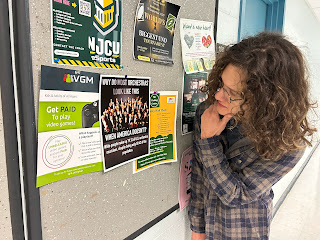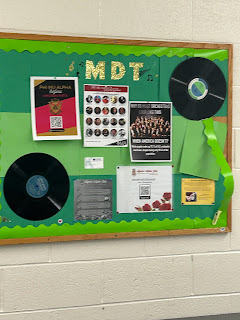For my intervention, I decided to base my posters off of the Guerrilla Girls, but tie it to a similar diversity issue in a different field of the arts. Like I previously mentioned in class, I'm a classical musician and I am also very passionate about diversity in the field of classical music. When we first discussed the Guerrilla Girls and their initial activism campaign when it came to diversity in the fine art world, I immediately drew the connection from that issue to the classical music world, where women and minorities are frequently underrepresented in both musicians and composers.
For my take on the same concept, I designed my own posters with statistics about minorities in classical music and printed them out to hang in the first floor of Rossey Hall, where most of the Music, Dance & Theater Department at NJCU congregates. When researching this topic, I knew there was going to be many different sources I could use, and what kind of statistics I could pull from them. My main source was from the League of American Orchestras’ 2023 Report on Racial/Ethnic and Gender Diversity in the Orchestra Field as it was the most up to date information I could find. My goal with my posters was to start a conversation, get people, specifically students, thinking about the broader implications of the classical music industry. So many higher education music schools enforce the teaching of classical music but don’t share what the reality of the classical music industry is like.
 |
| The poster about conductors outside Rossey 105, where both Concert Chorale & Symphony of Winds and Percussions rehearses (both conducted by men) |
 |
| The orchestra poster on a bulletin board where job opportunities usually go up |
For posters, I took images I found of real orchestras. Susan Sonntag describes photos by saying “Photographs furnish evidence. Something we hear about, but doubt, seems proven when we're shown a photograph of it.” By using an image of an actual orchestra that I found, I wanted to show exactly what the classical music industry looks like along with the statistics. When describing their own work, one of the Guerrilla Girls said “…our main message is to question what you’re seeing, don’t just accept what you see at institutions, you have to think about what’s not being shown, how did it get here?” In a similar way, I wanted NJCU students, who heavily skew non-white, to see what a real orchestra looks like, and question why it doesn’t look like our ensembles and have that uncomfortable conversation.
 |
| Both posters in the Rossey First Floor Lounge, where many music students meet up or pass the time. |
I already know that the posters are starting conversation as it’s started conversation in my own experience. When picking the posters up from Staples after being printed, it sparked a conversation with the cashier who mentioned that their dad works with an organization in New York that focuses on music and activism. While hanging up the posters with a friend, they questioned if I had to look up specifically all-white orchestras for the photo (I didn’t). A colleague from our ensemble was genuinely interested in the statistics when I hung up the posters. It’s a small step, but people are noticing it.
 |
| Member of our ensemble checking out the poster after rehearsal |
 |
| Friend who helped me hang them up |
Sources:
Racial/Ethnic and Gender Diversity in the Orchestra Field in 2023, League of a American Orchestras https://americanorchestras.org/racial-ethnic-and-gender-diversity-in-the-orchestra-field-in-2023/
Susan Sontag, excerpt from On Photography http://www.susansontag.com/SusanSontag/books/onPhotographyExerpt.shtml
Guerrilla Girls – 'You Have to Question What You See' | Artist Interview | TateShots https://www.youtube.com/watch?v=8uKg7hb2yoo



No comments:
Post a Comment